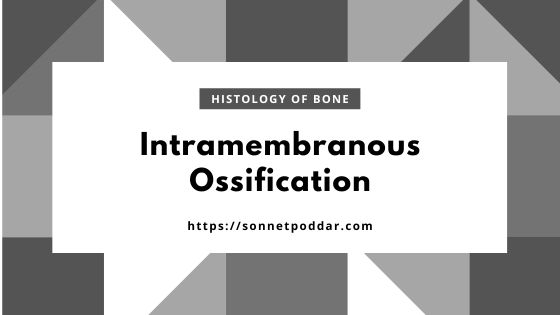Do you want to know about intramembranous ossification?
If so, please continue reading this article; I hope you will understand intramembranous ossification histology.
In this article, I will try to cover the intramembranous ossification definition, the steps of intramembranous ossification, the secondary ossification center, and others.
Intramembranous ossification occurs in the flat bones of the skull, such as the cranial cavity and facial bones. If you are really interested in intramembranous ossification histology, please continue this article.
Prerequisites for intramembranous ossification
Before to start intramembranous ossification histology, you should know the following topics –
- #1. Histology of bone
- #2. Histology of bone cells
- #3. Bone matrix
I hope you have a great idea about these topics; if you don’t, don’t worry. I will try to provide some information about them. Okay, let’s start by learning about bone histology.
Bone is specialized connective tissue that consists of bone cells and a bone matrix embedded in hard, unbending substances. Again, the matrix includes fibers and ground substances.
There are typically three types of bone cells: osteoblasts, osteocytes, and osteoclasts. Want to memorize the theme? Fine, let’s continue with me.
#1. Osteoblast
They are columnar to squamous in shape, and their cytoplasm is intensely basophilic
The nucleus is large, rounded, and located at the basal region of the cell
The organelles like the Golgi body and rough endoplasmic reticulum are prominent (in electron microscope)
They are responsible for the active formation and mineralization of bone matrix
#2. Osteocyte
They are the principal cell in mature bone and reside in a lacuna that is surrounded by calcified interstitial matrix
They are flattened in shape, and the nuclei are also flattened (located centrally)
Cytoplasm is faintly basophilic and has numerous long and slender process
They are responsible for the active maintenance of the bony matrix
#3. Osteoclast
They are large and multinucleated cells located at the surface of the bone.
The cytoplasm of these cells is acidophilic
The nucleus is oval
They are responsible for secretes acid and lysosomal enzyme
Bone matrix
The bone matrix is composed of fibers and ground substances (produced by osteoblasts). The fiber of bone matrix is generally collagen type I. The ground substance includes organic intercellular substances and inorganic components.
Organic intercellular substances: It contains glycosaminoglycan glycoprotein and collagen fiber.
Inorganic components contain hydroxyapatite crystals deposited as slender needles within collagen fiber networks, enhancing tensile strength. It also includes ions like calcium, phosphate, hydroxyl, and carbonate.
Process of intramembranous ossification
The process of bone formation is called osteogenesis. Osteogenesis is divided into intramembranous ossification and intercartilaginous or endochondral ossification.
In this article, we will learn about the first process of osteogenesis. Let’s find the endochondral ossification steps here.
You know, there is an osteoprogenitor cell from which bone cells are differentiated. Bone formation is a long process, but here, I will give a short and simple description so that you may get an idea of the full process.
Osteoprogenitor cells differentiate into osteoblast cells
Osteoblast cells begin to synthesize and secrete osteoid (a component of osteoid – first collagen and later ground substances)
Osteoblasts become surrounded by a partially mineralized matrix (containing visible collagen fiber)
More osteoids are produced, and complete mineralization occurs after osteoid production
The osteoblast becomes entrapped within the lacunae, and the osteoblast becomes osteocytes
Then the osteocytes produce the center of ossification (there you may find the small, isolated pieces of developing bone within the connective tissue)
Then it radiate in several directions and form trabeculae (which is also known as bony spicule or bony trabeculae; cancellous bone)
It increases in width and length by the addition of new lamellae and helps to form primary spongiosa of trabecular bone
Then, the mesenchymal space between trabeculae fills with osseous tissue except for a central canal, and it becomes compact (formation of compact bone)
Some common inquiries about intramembranous ossification
Osteoid: unmineralized matrix of bone (especially collagen fiber type I and proteoglycans). Calcium ion, along with alkaline phosphate, is hydrolyzed to form hexose phosphate. Hexose phosphate produces phosphate ions and gets combined with calcium. As a result, calcium phosphate crystal is precipitated in the bone matrix.
How does mineralization occur?
Osteoblasts synthesize and secrete an organic matrix and plasmalemma bud called matrix vesicles. These vesicles contain lipids, calcium ions, and alkaline phosphate and are required to initiate and maintain mineralization.
A component of the Haversian system or osteons: it includes the Haversian canal, lamellae, lacunae, canaliculi, interstitial lamellae, and Volkmann’s canal.
In the histology of compact bone, numerous narrow canals pass through the compact substance along the length of the bone; these narrow canals are called Haversian canals.
Around these canals, the bone matrix is present as concentric lamellae. In between the lamellae, there is a minute space called lacunae. Minute cannas radiate from these lacunae to accommodate the processes of bone cells and are called canaliculi.
In between the Haversian system or osteons, the triangular areas are filled with irregular bony deposits called interstitial lamellae.
Haversian canals communicate with the marrow cavity and with the surface of bones by some transverse canals, which are surrounded by bony lamellae. These transverse canals are called Volkmann’s canals.
I hope this little information will help you understand the basics of the intramembranous ossification process.
I used to publish this type of article (related to veterinary anatomy) on a regular basis here. If you are really interested in learning or getting some help from me, then you may follow this blog. Again, if you want to get updates fast, then you may also follow me on social media here; I hope you will get more images and videos there.
Conclusion
This article is informative and helpful in understanding the intramembranous ossification process. Please share it with your friends who want to learn about osteogenesis. I will be back as soon as possible with endochondral ossification steps.
If you have any suggestions or inquiries related to the histology of bone formation, feel free to contact me.

